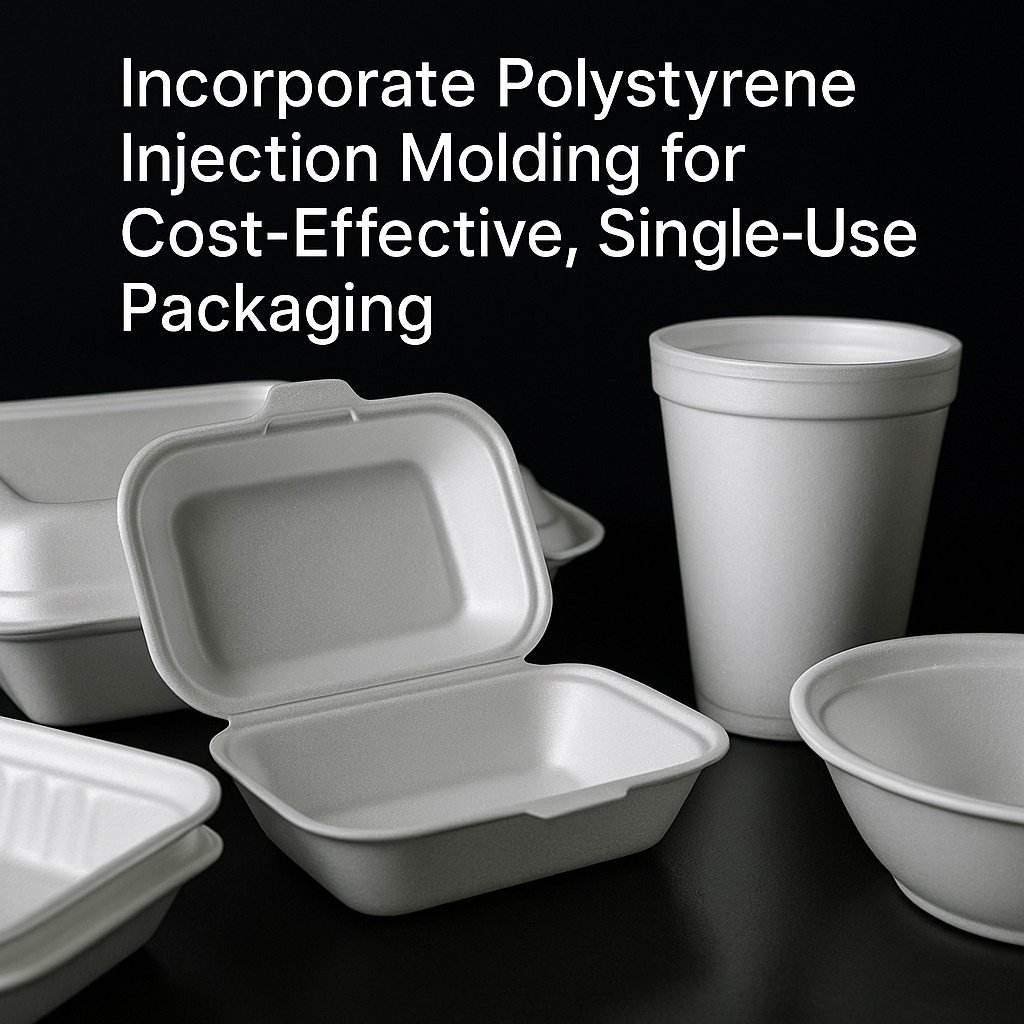Incorporate Polystyrene Injection Molding for Cost-Effective, Single-Use Packaging
Incorporate Polystyrene Injection Molding for Cost-Effective, Single-Use Packaging

Incorporate Polystyrene Injection Molding for Cost-Effective, Single-Use Packaging
Fast cycles • High gloss & printability • Food-contact ready (grade-dependent)
When you need lightweight, high-gloss packaging at aggressive price points, polystyrene (PS) delivers. It flows easily into thin walls, finishes with excellent surface quality, and supports high-cavitation tools that keep cost per unit low for single-use items—cups, yogurt pots, lids, portion tubs, blister trays, cutlery, and cosmetic pods.
Explore our end-to-end route from DFM to tooling to automated molding:
Custom Mold & Design Maker • Mold Service • Injection Mold • Molding • Customer Examples • Contact
Why Choose PS for Disposable Packaging?
-
Low piece price at scale: fast fill/pack/cool with short cycles on multi-cavity tools.
-
A-surface cosmetics: high gloss, crisp lettering, and excellent printability (pad/ink/label/IML).
-
Dimensional stability: low shrink helps lids and closures maintain fit.
-
Clarity or toughness options:
-
GPPS (general-purpose PS): clear, rigid, high gloss.
-
HIPS (high-impact PS): opaque, tougher for cutlery or snap features.
-
-
Food-contact grades available (check regional compliance and migration limits).
DFM & Part Design Tips (So It Molds Fast and Looks Great)
-
Wall & rib planning: uniform walls; ribs ≈ 40–60% of wall to control sink and cycle.
-
Draft: ≥ 1.0–1.5° on textured surfaces; ≥ 0.5° polished.
-
Corners/fillets: avoid sharp transitions to limit stress whitening and crack starts.
-
Stacking & denest: add stack lugs and denest features on cups/tubs to speed automation.
-
Snap fits: HIPS is preferred; keep strain below brittle limits and chamfer entry ramps.
-
Hinges: PS is not ideal for living hinges—use PP if a true living hinge is required.
Get a 48-Hour DFM Pack with gate/cooling/warpage plan and cycle model:
Tooling Architecture for PS Packaging
-
Cavitation: 4–32+ cavities typical for lids & trays; balanced manifolds for short cycles.
-
Gating: sub/tunnel gates for de-gate at ejection on high-cavitation lids; fan/film gates for cosmetic skins; valve gates where vestige must be hidden.
-
Cooling: parallel circuits; ΔT target ≤ 5 °C across cavities; consider Be-Cu inserts on hot spots for fast demold.
-
Ejection: stripper rings/plates for round cups/tubs; minimize pin marks on A-surfaces.
-
Surface finishing: high polish or fine texture to tune gloss and scuff resistance.
Tool execution & serviceability standards: Mold Service • Components & options: Injection Mold
Processing Window (Typical Starting Points*)
-
Melt temperature: ~180–240 °C (grade-specific)
-
Mold temperature: 30–60 °C (lower for cycle, higher for gloss)
-
Drying: PS absorbs little moisture; keep pellets clean/dry to avoid splay.
-
Notes: PS is sensitive to certain solvents; manage stress to prevent crazing.
*We’ll confirm with your resin data sheet during trials.
On-press optimization & scientific molding: Molding
Quality & Compliance
-
Food-contact: run specified GPPS/HIPS grades; supply COA and migration data when required.
-
Vision SPC: 100% checks for flash, short, splay, gate blush, and logo legibility.
-
Capability targets: CpK ≥ 1.67 at CTQs (fit, diameter, wall, flatness).
-
Traceability: MES logs OEE, CpK, scrap, energy kWh/kg, and lot genealogy.
See similar programs: Customer Examples
Cost, Throughput & Energy—Typical Wins
|
KPI |
Generic Cell |
Optimized PS Cell |
|---|---|---|
|
Cycle time (flat lid) |
6.8 s |
4.8–5.5 s |
|
Scrap rate |
2.0–3.0% |
≤ 1.0–1.2% |
|
OEE |
72–80% |
88–92% |
|
Energy (kWh/kg) |
0.55 |
0.42–0.48 |
Actuals vary by geometry, resin, and tool design.
Sustainability Considerations
-
PCR-PS & closed-loop options: where available, we can evaluate post-consumer recycled PS content and blend ratios.
-
Mono-material design: avoid metal inserts/labels when possible; prefer IML/print for recyclability.
-
Alternates: if hot-fill, dishwasher, or reusability is required, consider PP or PETG/PC with the same DFM.
Discuss ESG targets during RFQ so we can align materials and color governance.
→ Contact
Rapid Tools → Mass Production (Your Scale Path)
-
Aluminum or hybrid “bridge” molds for EVT/DVT and market tests.
-
Freeze design, then copy-cavity to H13/S136 multi-cavity steel with valve gates and conformal-cooled inserts where ROI is proven.
-
Transfer the golden recipe (cavity-pressure envelopes) and vision rules to each line/plant.
Start fast: Custom Mold & Design Maker
RFQ Template (Copy/Paste)
Subject: RFQ – Polystyrene Injection Mold for Single-Use Packaging
Attachments: STEP/IGES + 2D with CTQs & cosmetic map
-
Annual volume & first PO; SKU/colors; stacking/denest requirements
-
Material: GPPS or HIPS (target grade/MFR), food-contact region(s)
-
Part weight & wall targets; lid-to-cup fit specs (diameter/flatness/oval)
-
Tooling preference (cavity count; hot vs. cold; valve/sub-gate); ejection style (stripper/pins)
-
Surface finish (gloss/texture), logo/IML/label plan
-
Validation pack (FAIR, CMM/scan, CpK @ CTQs, color ΔE/gloss)
-
Automation scope (EOAT take-out, stacking, vision checks)
-
Data & traceability (MES access, kWh/kg, genealogy)
-
Packaging (bag/box/pallet), denest orientation, and export marks
We’ll convert this into a 48-Hour DFM & Cost Pack with cycle model and tooling roadmap.
Why TaiwanMoldMaker.com
-
Tooling depth: high-cavitation lids/tubs, valve-gated hot runners, conformal cooling, serviceable inserts.
-
Fast ramps: rapid bridge tools to production steel with consistent golden recipes.
-
Audit-ready data: scientific molding, vision SPC, and MES dashboards for OEE/CpK/scrap/kWh/kg.
Explore services & examples:
Injection Mold • Molding • Customer Examples
Call to Action
Ready to launch cost-effective single-use packaging in polystyrene? Send your CAD and targets to receive a 48-Hour DFM & Cost Pack—gating/cooling plan, cycle estimate, and a copy-cavity path to scale.








